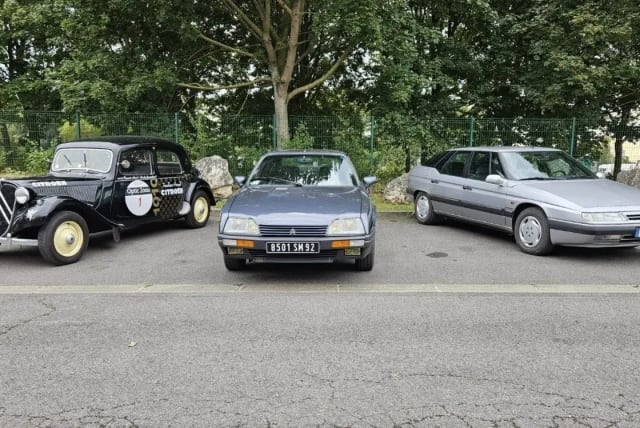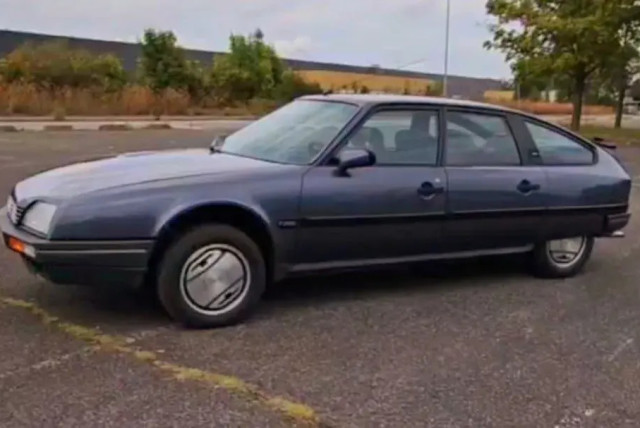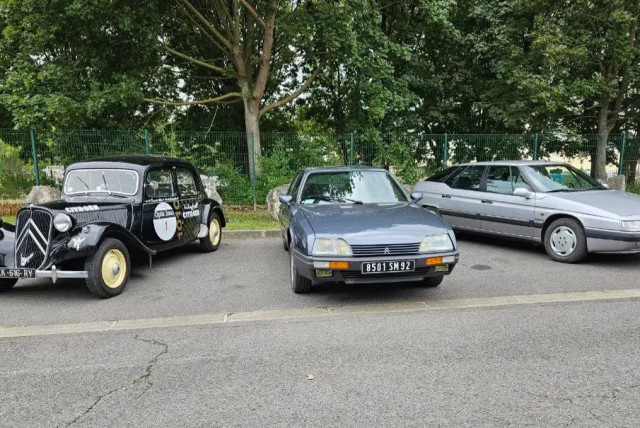Time Machines: Driving the Citroën Traction Avant and Its Legacy

Amid a worldwide economic downturn, André Citroën gambled his company's future on creating the first widely successful front-wheel drive car. Decades later, we experienced its revolutionary drive.
Visiting car museums is always an experience. While many car museums around the world are aimed at being a family outing place, the official Citroën museum in Saint-Denis is focused on the car enthusiast and fans of the French brand.
We are at the museum as guests of Citroën, and especially for us, they brought an English-speaking volunteer guide. Quickly, we focus on the Traction Avant. It was not the first Citroën; that honor belongs to the Model A, launched in 1919 as the first car produced by André Citroën's factory, which, just a year earlier, was still making gears for the French army. The ceasefire forced the Jewish businessman to find another product. Today we call such a company pivot. At that time, cars were the high-tech.
There are very few cars in the world that can be said to have truly made a change in the automotive world. It is common to think that with Citroën it is the original Citroën DS, but the truth is that the car that transformed Citroën and created the glorious history of the avant-garde French manufacturer is the Traction, as it is affectionately and shortly called.
Most of you may have heard about it here and there, but the Traction Avant was so innovative and advanced that it was produced from 1934 to 1957, meaning it survived even World War II and the technological leap that this terrible war brought with it.
Citroën believed in innovation. He was the first in Europe to build cars in mass production after sailing to see the wonder at Ford's factory in the USA. He acquired the right to place the CITROEN inscription on the Eiffel Tower to create awareness for the new manufacturer.
And at the beginning of the 30s of the 20th century, in a period of global economic crisis, he understood that only innovation would allow his company to survive. He was partly right.
The Eiffel Tower illuminated with the letters CITROEN in 1925The Eiffel Tower illuminated with the letters CITROEN in 1925/CitroënThe then holy grail of the automotive field was front-wheel drive. It was clear that this configuration would be safer and more efficient, but the challenge was to design wheels that would both steer the car and propel it. Alvis in England, Cord in the USA, and DKW in Germany had already produced such cars, but on a small scale. Citroën decided on full mass production and to incorporate another innovation into the new car: a monocoque chassis. Until then, all cars were built on a ladder frame, a separate body and frame: one chassis that would unite the two would be lighter and stronger. And if that wasn't enough, it was determined that the new car would be the first with hydraulic, power-assisted brakes.
He built a new factory for the company near Paris, while the development was conducted like a race against time, due to mounting debts and pressing creditors. On April 19, 1934, production began. To dispel claims that a unified chassis is not strong enough, he organized a sort of primitive crash test for it and for the media. First, a Citroën A rolled down a slope and completely disintegrated on its way down. After it, a Traction Avant rolled down.
Her body reached the ground almost intact, to the extent that the windows still went up and down with the turn of the handle. Granted, with a little more advanced thinking, the audience would understand that without safety belts which were not yet installed in private cars at that time (thanks, Volvo), no one would survive such an accident, but the photos of the complete car were very impressive.
By September, 22,000 units of the first model, the 7, had already been produced and sold, and the Traction Avant, "front-wheel drive" in French, had become a highly esteemed hit. Citroën the company was saved, but it was too late for Citroën the man. By the end of the year, the courts would transfer control of the company to its largest creditor, the tire manufacturer Michelin. Within a year, he would pass away from cancer at only 57 years old. The Chief Rabbi of France would conduct his funeral at the Montparnasse cemetery. Citroën did not live to see the rest of the world drive forward in his footsteps, largely abandoning rear-wheel drive.
Almost 760,000 Traction Avant cars were built during the production period, with two years where it was produced parallel to its successor, which was revolutionary in its own right.
I hope that you have been convinced of how significant the Traction is, both for Citroën itself and for the automotive industry as a whole, and today, as mentioned, we are visiting the Citroën Museum, as guests of Citroën, and when guests ask very nicely, and make sad eyes, even the toughest of the French mechanics there can't resist. From there, three impressive cars roll out of the large hangar - the Traction Avant (which should be pronounced "Traksion Avan"), Citroën CX GTI, which replaced the DS, and Citroën XM, which replaced the CX.
Firstly, the Traction, which, unlike the other cars and according to the era it was designed in, also presents a challenge in starting and driving. The front doors open in reverse, meaning you pull the handle near the front part, and the door hinge is on the car's middle pillar.
The entrance is easy, and the seating position is relatively upright. Don't look here for body support or an enveloping seat, yet it is still very comfortable. To drive, you turn on the ignition switch, pull the starter lever and the engine comes to life with the murmur of something old. A smell of time envelops us, like an old armchair, mixed with the scents of oil and fuel. The 1,911 cc, 60 hp engine operates almost smoothly, mechanical noises are heard actually from the gearbox, which even 89 years ago was considered its weak point.
The gearshift is located on the dashboard, with the gearshift housing made of shiny chrome with numbers for the gears. Down to the right for first gear, up and to the left for second gear, and down to the left for third gear, and that's it. Up to the right will engage the traction for reverse.
The steering wheel is large and thin, without power assistance. Once your hands synchronize with the car, you are surprised by how easily the car handles. Even though the car we drove is from 1955, driving it is easy, and the feeling is of a very pleasant vehicle to drive.
There are no advanced safety features here, such as safety belts of any kind, and certainly no advanced technology of any kind. Think 1934, it's really like that. But this simplicity and the softness of the car are addictive. The car has no problem accelerating even to third gear and quickly reaching completely modern speeds. That's how it is when switching to a unified chassis reduced the kilograms; the first Traction Avants weighed 1,025 kg, less than a new Citroën C3. That's how it is without all the modern creature comforts and safety equipment. Yes, no air conditioning either. But despite the respectable dimensions, it's not really more spacious than a new small family car. Space utilization is a practical art that was only learned later.
How do you convey such an experience in reading? Very difficult. So I filmed some videos for you so you can participate in the experience. I finish the driving chapter of the Traction Avant, and taking advantage of a moment of distraction from my friends, I determinedly leap into the driver's seat of the CXGTI.
The CX, as mentioned, is the successor to the DS, which in turn replaced the Traction Avant. The Citroën CX is a large 'executive' car, with a front engine and front-wheel drive, produced between 1974 and 1991 in various configurations.The CX's wheelbase stands at 2.845 meters, with an overall length of 4.67 meters. The weight is quite amusing by modern terms, ranging from 1,265 kg to 1,520 kg depending on the model. A total of 1.2 million units were produced and sold in different markets around the world, including a stunning station wagon version.
The CX already has Citroën's hydropneumatic suspension, and the one we are driving also features a manual gearbox. However, it is not licensed for driving on public roads, so I am content with driving in Citroën's large parking lot.The first thing that stands out is the comfort. Even though the car is from 1985, I can't recall a modern car that offers such a high level of comfort. The car, which is part of the Citroën museum's collection, is maintained to the highest standards, therefore it is almost perfect both externally, with a silhouette so identified with the model and the smaller GS series, and internally as well. Soft and pleasant leather upholstery, and a Citroën passenger compartment from the 80s. The engine starts at a touch, and from there the driving is in a car that is modern by post-40-year terms. The gears integrate smoothly, the car brakes well, and you get used to the steering as well, both to the single hub and to its strong centering the moment you let go of the steering wheel. A real pleasure, and I move on to experience the modern XM.
The XM replaced the CX as the French manufacturer's 'flagship', and was marketed between 1990 and 2000. The wheelbase is identical to that of the CX and stands at 2.845 meters, with an overall length of 4.71 meters. Citroën produced over 300,000 units of the XM model.
The demonstration vehicle they delivered to us, a refined machine, has a 2.5-liter turbo diesel engine (130 hp) with a manual transmission. I settle into the car and the first thing I think about is relief for all my muscle aches, back and neck. The body rests on a pleasant cloud and it's enjoyable. To drive, you need a running engine, and I can't manage to start the car. Even finding the car's original ignition key does not help, until a Danish press colleague comes to my aid and explains the correct procedure for starting the car.
The start of the drive proves just how advanced and impressive Citroën's suspension system is. The car has excellent road grip, while smoothing out any disruptions or bumps, whether on the test track or on public roads. Imagine an invisible hand quickly passed in front of you on the road and made sure that there were no bumps or holes. Nothing short of amazing.
The turbo diesel engine pulls with determination, and the large XM easily picks up speed. The feeling is that one could now continue with the car on a journey to Israel, without stops and without effort. In the back, the space is impressive, and the seats are soft and comfortable. Only insistent requests from my colleagues to visit the museum bring me back to reality and allow them to also experience the sensation.
To summarize, if you are in France and you are car enthusiasts, set aside at least half a day for yourselves, and drive to the Citroën museum near Paris. For full details.
The building might not look impressive from the outside, but inside the museum lies an experience for every car enthusiast. Don't come with partners who don't like cars. Take your time, breathe in deeply the unique smell of the place, and patiently go from car to car. I promise you several hours of pure enjoyment.
The writer was a guest of Citroën.
Jerusalem Post Store
`; document.getElementById("linkPremium").innerHTML = cont; var divWithLink = document.getElementById("premium-link"); if (divWithLink !== null && divWithLink !== 'undefined') { divWithLink.style.border = "solid 1px #cb0f3e"; divWithLink.style.textAlign = "center"; divWithLink.style.marginBottom = "15px"; divWithLink.style.marginTop = "15px"; divWithLink.style.width = "100%"; divWithLink.style.backgroundColor = "#122952"; divWithLink.style.color = "#ffffff"; divWithLink.style.lineHeight = "1.5"; } } (function (v, i) { });



